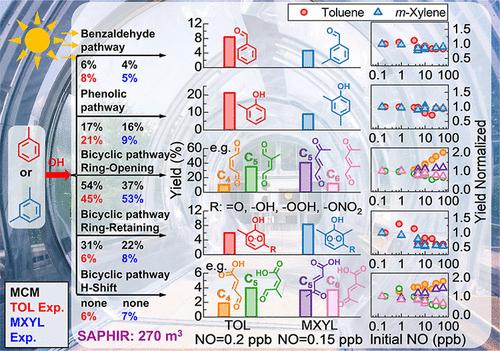芳烃氧化产物no依赖性产率的实验研究
IF 11.3
1区 环境科学与生态学
Q1 ENGINEERING, ENVIRONMENTAL
引用次数: 0
摘要
芳香烃在城市臭氧和二次有机气溶胶的形成中起着至关重要的作用,影响着空气污染、气候变化和人类健康。然而,它们的氧化机制仍然不确定,特别是在低一氧化氮(NO)条件下(<5 ppb)。利用SAPHIR实验箱,研究了在初始NO浓度为150 ~ 20 ppb的条件下,主要氧化产物的产率及其对NO的依赖性。对于甲苯(间二甲苯)氧化,低no实验条件下苯甲醛、酚类产物和有机过氧自由基(RO2)开环、保留双环和移h反应产物的产率分别为8%(5%)、21%(9%)、45%(53%)、6%(8%)和6%(7%)。双环途径的产率对NO的敏感性最强。MCMv3.3.1机制模拟产率与实验结果的比较显示出显著差异,甲苯氧化过程中双环开环和持环产物的模型测量值差异为+9%和+25%,间二甲苯氧化过程中酚、双环开环和持环产物的模型测量值差异为+7%、- 16%和+14%。值得注意的是,不包括在模型中的H-shift RO2反应产物的产率与双环闭合产物相当,对甲苯的碳闭合贡献了5-8%,对间二甲苯氧化贡献了6-8%。本文章由计算机程序翻译,如有差异,请以英文原文为准。

Experimental Insights on the NO-Dependent Yields of Aromatic Hydrocarbon Oxidation Products
Aromatic hydrocarbons play a critical role in the formation of urban ozone and secondary organic aerosols, impacting air pollution, climate change, and human health. However, their oxidation mechanisms remain uncertain, particularly under low nitric oxide (NO) conditions (<5 ppb). Using the SAPHIR chamber, this study investigated the yields of key oxidation products and their NO dependence under initial NO concentrations varying from 150 ppt to 20 ppb. For toluene (m-xylene) oxidation, the low-NO experimental yields of benzaldehyde, phenolic products, and products from bicyclic ring-opening, bicyclic ring-retaining, and H-shift reactions of organic peroxy radicals (RO2) were 8% (5%), 21% (9%), 45% (53%), 6% (8%), and 6% (7%), respectively. The yields from the bicyclic pathway showed the strongest NO sensitivity. A comparison between the MCMv3.3.1 mechanism-simulated yields and experimental results revealed notable discrepancies, with model─measurement differences of +9% and +25% for the bicyclic ring-opening and ring-retaining products in toluene oxidation and +7%, −16%, and +14% for the phenolic, bicyclic ring-opening, and ring-retaining products in m-xylene oxidation. Notably, products from H-shift RO2 reactions, not included in the model, showed yields comparable to bicyclic closed-ring products, contributing 5–8% to carbon closure in toluene and 6–8% in m-xylene oxidation.
求助全文
通过发布文献求助,成功后即可免费获取论文全文。
去求助
来源期刊

环境科学与技术
环境科学-工程:环境
CiteScore
17.50
自引率
9.60%
发文量
12359
审稿时长
2.8 months
期刊介绍:
Environmental Science & Technology (ES&T) is a co-sponsored academic and technical magazine by the Hubei Provincial Environmental Protection Bureau and the Hubei Provincial Academy of Environmental Sciences.
Environmental Science & Technology (ES&T) holds the status of Chinese core journals, scientific papers source journals of China, Chinese Science Citation Database source journals, and Chinese Academic Journal Comprehensive Evaluation Database source journals. This publication focuses on the academic field of environmental protection, featuring articles related to environmental protection and technical advancements.
 求助内容:
求助内容: 应助结果提醒方式:
应助结果提醒方式:


